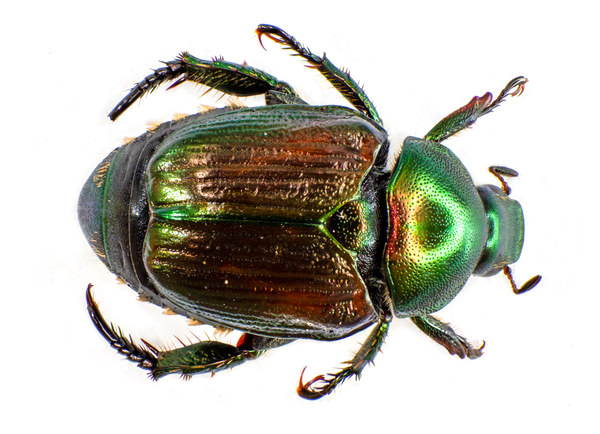One interesting application of nanotechnology to art is in respect to color. While most people think of pigment as artists' main means of creating color, another way is to use structural color which can be even more dynamic and vibrant.
As described in “Bright Colors by Nanotechnology,” structural color is produced by “nanostructures that cause reflected light waves to overlap” and generate interference. Depending on the nature of the reflected light, the eye will pick up different colors. Because of this, scientists can “precisely tune which wavelengths are reflected, creating ultra-pure colors,” or make “the surface transparent to select colors or polarizations of light” (Mitchel).
Because of the advanced understanding of physics, optics, and precise manipulation of nanostructures involved in creating structural color, one would guess this technique was modern, attained using cutting edge technology. While it is certainly a focus of modern research, structural color has actually been around for centuries and even exists in nature.

One interesting application of structural color is stained glass. The technique used to create different colored panes relies on nanoparticles within the glass. Specifically, red and yellow colors are due to “nanoparticles of gold and silver created during the glass [making] process” (Zenner). Additionally, according to “Bright Colors by Nanotechnology,” “nature produces shimmering iridescent colors using nanostructures;” this is the secret behind the eye-catching butterfly wing or beetle shell. Through these examples, it becomes clear that the interaction of nanostructures and light can be used to create incredibly intense and dynamic colors.

Artists today are looking to harness this technique in their own studios. One such artist is Kate Nichols who “has spent seven years as an artist in residence at a world-class nanotech lab, mastering technically challenging synthesis techniques and learning about colloidal chemistry and optical physics” (Carstensen). Her dedication stems from an interest in colors found in nature that cannot be fully captured by pigments. Her research is mainly focused on nanoparticles; she changes their size and shape in order to produce different colors. Structural color adds new dimension to her art as well as others’ and in doing so displays an important application of science, specifically nanotechnology, to art.

Art Using Nanoparticles (Nichols)
Sources:
“Bright Colors by Nanotechnology.” Nanowerk, https://www.nanowerk.com/nanotechnology-news/newsid=45102.php. Accessed 18 May 2021.
Carstensen, Jeanne. “The Ambiguous colors of Nanotechnology.” Nautilus, https://nautil.us/issue/26/color/the-ambiguous-colors-of-nanotechnology. Accessed May 18 2021.
“Colors at the Nanoscale: Butterflies, Beetles, and Opals.” National Informal Stem Education Network, https://www.nisenet.org/catalog/colors-nanoscale-butterflies-beetles-and-opals. Accessed 18 May 2021.
Mitchel, Kaih and Matt Thomas. “Understanding Color at a Nanoscale.” PhysOrg, https://phys.org/news/2019-12-nanoscale.html. Accessed 18 May 2021.
Nichols, Kate. “The Biological Significance of these Sequences is Not Known 5.” Kate Nichols, https://www.katenicholsstudio.com/#/biological/. Accessed 18 May 2021.
PtrQs. “The North Rose Window.” Wikipedia, https://en.wikipedia.org/wiki/Stained_glass#/media/File:Chartres_RosetteNord_121_DSC08241.jpg. Accessed 18 May 2021.
Richter, Ron. “Japanese Beetle.” Sheridan Media, https://sheridanmedia.com/news/30598/japanese-beetle-infestation-prompts-water-restrictions/ .
Accessed 18 May 2021.
Zenner, Greta. “Nanoparticle Stained Glass.” Nanoscale Informal Science Education, https://chem.beloit.edu/edetc/EExpo/nanostainedglass/Nanostainedglass_tabletop_FINAL.pdf. Accessed 18 May 2021.


You wrote a very interesting analysis of structural color. I was also fascinated by the nanostructure of objects from nature, particularly the Blue Morpho butterfly. It is wonderful to see how beauty is actually composed of so many complex and invisible structures. You also mention structural color in stained glass. I wonder if the stained glass creators knew exactly why ingredients such as gold and silver produced various colors especially since technology to view nanostructures was created fairly recently.
ReplyDelete